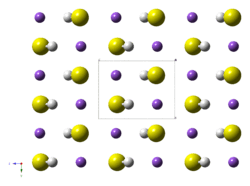Sodium hydrosulfide
 | |
| Names | |
|---|---|
| IUPAC name
Sodium hydrosulfide | |
| Other names
Sodium bisulfide Sodium sulfhydrate Sodium hydrogen sulfide | |
| Identifiers | |
| 16721-80-5 207683-19-0 (hydrate) | |
| 3D model (Jmol) | Interactive image |
| ChEMBL | ChEMBL1644699 |
| ChemSpider | 26058 |
| ECHA InfoCard | 100.037.056 |
| EC Number | 240-778-0 |
| 6278 | |
| PubChem | 28015 |
| RTECS number | WE1900000 |
| UNII | FWU2KQ177W |
| |
| |
| Properties | |
| NaHS | |
| Molar mass | 56.063 g/mol |
| Appearance | off-white solid, deliquescent |
| Density | 1.79 g/cm3 |
| Melting point | 350 °C (662 °F; 623 K) (anhydrous) 55 °C (dihydrate) 22 °C (trihydrate) |
| 50 g/100 mL (22 °C) | |
| Solubility | soluble in alcohol, ether |
| Structure | |
| rhombohedral | |
| Hazards | |
| Main hazards | Flammable solid, stench, releases hydrogen sulfide |
| Safety data sheet | TDC MSDS |
| R-phrases | R17 R23 R24 R25 |
| NFPA 704 | |
| Flash point | 90 °C (194 °F; 363 K) |
| Related compounds | |
| Other anions |
Sodium hydroxide Sodium amide |
| Other cations |
Ammonium hydrosulfide |
| Related compounds |
Sodium sulfide |
| Except where otherwise noted, data are given for materials in their standard state (at 25 °C [77 °F], 100 kPa). | |
| | |
| Infobox references | |
Sodium hydrosulfide is the chemical compound with the formula NaHS. This compound is the product of the half neutralization of hydrogen sulfide with sodium hydroxide. NaHS is a useful reagent for the synthesis of organic and inorganic sulfur compounds, sometimes as a solid reagent, and more often as an aqueous solution. Solid NaHS is colorless and typically smells like H2S due to hydrolysis by atmospheric moisture. In contrast with sodium sulfide, Na2S, which is insoluble in organic solvents, NaHS, being a 1:1 electrolyte, is more soluble. Alternatively, in place of NaHS, H2S can be treated with an organic amine to generate an ammonium salt. Solutions of HS− are sensitive to oxygen, converting mainly to polysulfides, indicated by the appearance of yellow.
Structure and properties
Crystalline NaHS undergoes two phase transitions. At temperatures above 360 K, NaHS adopts the NaCl structure, which implies that the HS− behaves as a spherical anion due to its rapid rotation leading to equal occupancy of eight equivalent positions. Below 360 K, a rhombohedral structure forms, and the HS− sweeps out a discoidal shape. Below 114 K, the structure becomes monoclinic. The analogous rubidium and potassium compounds behave similarly.[1]
NaHS has a relatively low melting point of 350 °C. In addition to the aforementioned anhydrous forms, it can be obtained as two different hydrates, NaHS·2H2O and NaHS·3H2O. These three species are all colorless and behave similarly, but not identically.
Preparation
The usual laboratory synthesis entails treatment of sodium methoxide, NaOMe, with hydrogen sulfide:[2]
- NaOMe + H2S → NaHS + MeOH
Industrially, NaOH is employed as the base. The quality of the NaHS can be assayed by iodometric titration, exploiting the ability of HS− to reduce I2.
Applications
Thousands of tons of NaHS are produced annually. Its main uses are in cloth and paper manufacture as a makeup chemical for sulfur used in the Kraft process, as a flotation agent in copper mining where it is used to activate oxide mineral species, and in the leather industry for the removal of hair from hides.
References
- ↑ Haarmann, F.; Jacobs, H.; Roessler, E.; Senker, J. (2002). "Dynamics of anions and cations in hydrogensulfides of alkali metals (NaHS, KHS, RbHS): A proton nuclear magnetic resonance study". J. Chem. Phys. 117 (3): 1269–1276. doi:10.1063/1.1483860.
- ↑ Eibeck, R. I. (1963). "Sodium Hydrogen Sulfide". Inorg. Synth. Inorganic Syntheses. 7: 128–31. doi:10.1002/9780470132388.ch35. ISBN 978-0-470-13238-8.
